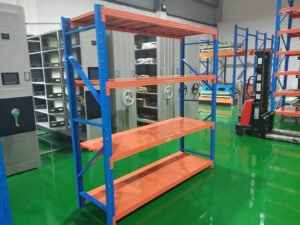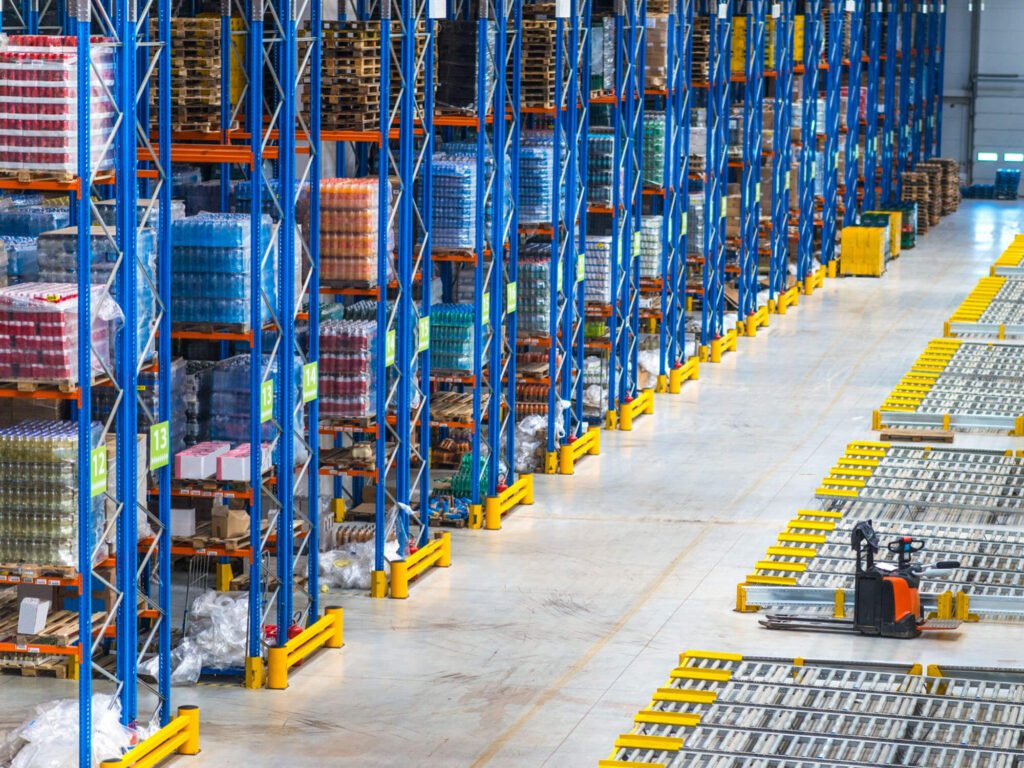“What is ASRS?” is undoubtedly one of the most frequently asked questions for newcomers to working in warehouses. That abbreviation refers to Automated Storage and Retrieval Systems, a solution that helps keep stored products effectively and safely in a compact area.
Specifically, the ASRS technology automates the handling of huge goods loads by combining a variety of vehicles and equipment. But the best part is that it can do those tasks precisely with little human intervention. In other words, ASRS can completely remove the possibility of error in warehousing operations.
However, there are numerous types of ASRS that may confuse you during the selection process. Each type comes with a different set of benefits and drawbacks, making it suitable for certain business situations. This article will guide you through all popular types of ASRS, as well as other in-depth information about this technological marvel!
What Is ASRS? – A Brief Introduction
Automated Storage and Retrieval Systems, or AS/RS, use computers, software, and robots to automate item handling, storage, and retrieval in warehouses. When necessary, certain types of ASRS can expand into a sophisticated automation network, managed by an appropriate software solution.
These automated solutions can help speed up production and shipping processes, as long as everything is kept in the correct area. Warehouse professionals often utilize AS/RS when there’s a demand to move large volumes quickly and precisely.
How Does ASRS Work, Exactly?
Certainly, the above definition is still too broad and cannot satisfy those curious about the topic. Thus, this section will give you a more specific picture of how ASRS works in most warehouses. Here’s the process breakdown:
- Firstly, new goods entering the warehouse will have their information (barcode, RFID, etc.) read and scanned by sensors. Then, the system identifies the best storage place for the products based on a set of characteristics, like dimensions and type, and places them on means such as conveyor belts for the transfer.
- Secondly, stacker cranes, which move vertically and horizontally, collect products from the conveyor belt and precisely arrange them on the predetermined storage spots via the use of optical sensors and positioning mechanisms.
- Lastly, when items need to be retrieved, the stacker crane gets system instructions, locates them, and gets them from the inventory location. Subsequently, these goods are placed on the conveyor belts again for transfer to the picking or shipping area.
Throughout the procedure, photoelectric sensors, laser scanners, and other safety devices are put to use to avoid collisions and ensure proper functioning. Additionally, the Warehouse Management System (WMS) and Warehouse Control System (WCS) coordinate the movements of the different components and maintain inventory levels, thus controlling and optimizing the whole operation.
Advanced ASRS solutions can also connect with other warehouse automation technologies, such as pick-to-light and automatic sorting systems, to provide complete end-to-end automation.
General Benefits Of Employing ASRS For Your Warehouse
Now that you’ve learned about what ASRS is and how it works, let’s look at some of the advantages of employing this technology. Some of the benefits below are what make ASRS a must-have system for major businesses.
- Increasing inventory space: As companies grow every year, the need for more inventory space becomes essential. But this real estate is not only limited but also costly to add. ASRS can resolve the concern by maximizing warehouse floor areas via its compact size and optimal use of vertical space.
- Enhancing stock management: This automated system can integrate with various Warehouse Management Systems to enable improved inventory control. Moreover, ASRS offers more accurate information about stock levels, thereby decreasing the likelihood of missing goods and the associated expenses.
- Augmenting operational versatility: Warehouses do not remain the same throughout the year, as market demands always fluctuate. However, thanks to the modular structure of ASRS, you can customize or even expand it to anticipate any big major market change. This helps you reduce the initial cost of large-scale automation while gradually transitioning to complete automation.
- Reducing human errors: Mistakes can be both harmful to workers and detrimental to your business’s profitability. When an employee selects and packs the incorrect item, consumers get unhappy, and expenses increase. Yet, ASRS can prevent all of these errors as it obtains top-notch precision, leading to higher customer satisfaction.
- Boosting warehouse safety: This benefit is kind of like the outcome of the above advantage. As ASRS helps eliminate human errors, which can lead to safety concerns, it certainly can lower the risk of accidents and bring about a safer working environment for your employees.
- Lowering labor expenses: Labor expenditures can account for over half of a warehouse’s overall budget. Having staff manually travel and pick items requires a sizable workforce and demands a lot of time. Yet, by using ASRS, you can minimize dependency on manpower, thereby lowering related expenses.
- Facilitating productivity gains: ASRS makes it possible to operate continuously 24/7 by incorporating robots, which don’t need breaks like humans. Although this automation cannot perform all warehouse operations, it surely facilitates productivity gains by enabling employees to pick orders more quickly.
Understanding The Top 10 Types Of ASRS
As mentioned above, the world of ASRS is vast. In addition to its general workflow and benefits, there are still a wide variety of aspects you should get your mind around. The following are the 10 most popular types of ASRS available on the market.
#1: Unit-Load ASRS
Most warehouse operators choose this ASRS type to handle huge and heavy loads weighing from 450 to 2,500 kilograms. This functionality enables the unit-load ASRS to handle both whole and partial pallets of goods.
Regarding the structure, unit-load ASRS typically comprises narrow-aisle racks that can reach over 30 meters in height and contain pallets of merchandise. These racks work in tandem with a crane to physically deposit and pick up pallets as required. In this first category, there are two subtypes of unit-load ASRS, as follows:
- Fixed-aisle: This subtype includes a crane that traverses the small aisles to fetch and stock products using vertical and horizontal movements. And as the name suggests, this crane is securely attached to a single aisle.
- Movable-aisle: Like the fixed-aisle type, movable-aisle unit-load ASRS shares a similar structure with a crane that moves between small aisles of pallets on a track. Yet, what makes it different is that the crane is not bound to a certain aisle, allowing the system to work in a larger working area.
PROs:
- Being a high-density storage solution.
- Streamlining pallet handling.
- Offering efficient handling of large loads.
CON:
- Demanding a high initial investment.
#2: Mini-Load ASRS
Instead of full pallets, mini-load ASRS is the preferred solution for firms that want to store cartons, totes, and trays of a large number of items, especially if these businesses lack the floor space to deploy the traditional carton-flow racking system.
This technology generally consists of stacker cranes, system-controlled software, a pickup platform, and a racking structure. During the handling of stored items, the crane moves along an aisle between racks while a loading device traverses the crane’s height to reach the necessary goods location and collect the products.
Then, the crane returns to the aisle’s end to deposit the items for the next stages. This inventory method is better suited for more lightweight loads (up to 35 kilograms). Aside from automatically replenishing pick sites, mini-load ASRS is also capable of arranging products into picking and packing zones.
PROs:
- Well-suited for small item storage.
- Enhancing picking accuracy.
- Optimizing warehouse space utilization.
CON:
- Providing relatively low load capacity.
#3: Micro-Load ASRS
For those who are looking for a solution that can simplify the storage and retrieval of individual cartons and totes, look no further than the micro-load ASRS. It is beneficial for both buffering and sorting items in small inventory facilities.
This type of ASRS contains an extractor tool that moves around the system’s core to pick up a specific queue of products and discharge them onto a conveyor belt or workstation. The products can then wait there until they are needed.
Although there are various micro-load ASRS subtypes, most of them only take one item in a single pass. A few more complex designs can handle up to five products per pass. One great thing about this ASRS type is that you can integrate it with other automated systems to improve performance while considerably lowering floor space requirements.
PROs:
- Facilitating high-speed picking.
- Ideal for storing small parts.
- Enhancing inventory accuracy.
CON:
- Providing limited storage capacity per unit.
#4: Autonomous Mobile Robots (AMRs)
If you often read materials about warehouse operations, then you might already know that AMRs stand for Autonomous Mobile Robots. This is a high-density ASRS solution that uses three-axis robots to climb vertically up a storage rack and retrieve the required tote or case, and then proceed down the rack and approach the pick workstations.
The warehouse staff often enters the required commodities and quantities into the batch orders before instructing the AMRs to leave for their next assignments. These robots depend on those inputs, which are saved in the integrated pick-to-light technology, to carry out their tasks.
The brilliant aspect of AMRs is that this system is very versatile with regard to throughput, inventory density, and staffing requirements. You can even add, delete, or rearrange additional racks and AMRs to meet current and anticipated activity levels.
PROs:
- Highly adaptable to changing layouts.
- Having high scalability.
- Requiring minimal infrastructure investment.
CON:
- Having quite low load capacity.
#5: Autonomous Guided Vehicles (AGVs)
In contrast to AMRs, Autonomous Guided Vehicles (AGVs) are adaptable, portable robots that transfer items in industrial environments such as warehouses and factories. These vehicles navigate independently utilizing a variety of methods, including floor markings, vision cameras, lasers, and radio waves, to ensure accurate mobility.
AGVs make it easier to carry raw materials, like paper, rubber, and metals, from receiving to storage or straight to manufacturing lines, guaranteeing that supply chains run smoothly. In addition, these technologies play an important role in incoming and outgoing handling, stock replenishment, and picking.
PROs:
- Relatively cost-effective.
- Reducing labor demands.
- Versatile for numerous material handling tasks.
CON:
- Operating relatively slowly.
#6: Shuttle-Based ASRS
Powered by batteries or capacitors, shuttles in this ASRS solution help carry inventory by traveling along a track between shuttle racking towers. Depending on your operation’s needs, these bots can operate on one or more levels.
How does shuttle-based ASRS work, exactly? Well, the shuttles visit the product’s location and retrieve the cartons holding the desired items upon request. Following that, these gadgets will carry the cartons towards a conveyor, which will further deliver everything to a workstation.
There are two primary variations of shuttle-based ASRS. The first one is when the shuttles move on the ground before rising up the vertical rack to grab the desired items. The second one is when these bots traverse the rack’s height before approaching an aisle to acquire the necessary cartons and carry them to the eventual workstation.
PROs:
- Offering high throughput rates.
- Lowering aisle space requirements.
- Increasing storage density.
CON:
- Requiring high upfront setup costs.
#7: Carousel-Based ASRS
Instead of shuttles, the following ASRS solution utilizes up to three layers of carousels, or inventory bins, to constantly move goods along a track to a workstation. Furthermore, it has the ability to recover returned products and restore them to the waiting shelf.
What makes this ASRS type special is that all carousels in the system run independently to deliver the necessary goods to an extractor tool that moves across the warehouse floor.
Warehouse professionals often classify carousel-based ASRS into two main subtypes: horizontal carousels and vertical carousels. While the former facilitates the horizontal movements of carousels and is ideal for minor items like papers, the latter has carousels that revolve vertically like a ferris wheel.
PROs:
- Providing continuous item access.
- Reducing picking time.
- Having a space-efficient design.
CON:
- Hard to scale for larger operations.
#8: Vertical Lift Modules (VLMs)
This next ASRS variation is an enclosed system made up of two columns of trays and features an extractor in the middle that delivers trays of stored objects to operators as required. When in action, the extractor of this goods-to-person solution will locate the relevant tray for the desired item, collect it, and deliver it to the warehouse worker.
Once the order is fulfilled, these Vertical Lift Modules, or VLMs, will return the tray to its proper location before retrieving the next one. Regarding the tray, you can select between the dynamic-tray system (trays’ locations vary) and the fixed-tray system (trays’ locations stay fixed).
PROs:
- Maximizing vertical space utilization.
- Improving picking precision.
- Shrinking picking duration.
CON:
- Needing a high investment compared to traditional methods.
#9: Vertical Sequence Modules (VSMs)
This ASRS method is quite comparable to micro-load ASRS, which also features a picker located among the racking structure that moves back and forth to choose required items and transfers them to a conveyor or an eventual workstation.
Oftentimes, Vertical Sequence Modules are an enclosed system, with the picker maneuvering freely inside the racking zone. Besides product handling, this ASRS variant also restores the stored products to their rightful spots after completing the request before proceeding with the subsequent process.
PROs:
- Offering dynamic sequencing capabilities.
- Fulfilling orders efficiently.
- Reducing picking errors.
CON:
- Requiring a complex system setup.
#10: Vertical Buffer Modules (VBMs)
It’s a fact that ASRS is an expensive technology that is not meant for all warehouses. However, if you are looking for a relatively affordable option among the category, Vertical Buffer Modules (VBMs) are potential.
These systems have an enclosed shelf structure for storing and retrieving totes, with a moving mast located in the middle. With VBMs, you can effortlessly maximize warehouse space utilization while ensuring simple access to stored products.
Another benefit of this ASRS type is its ability to transport totes to ergonomic picking stations, which increases worker productivity and reduces strain. It also interacts seamlessly with outward conveyors, thereby optimizing operations and increasing throughput.
PROs:
- Handling totes efficiently.
- Improving accuracy in inventory processing.
- Offering optimal space utilization.
CON:
- Having relatively slow retrieval speeds.
Do You Really Need ASRS?
Although ASRS comes with numerous convincing benefits, it is definitely not a viable solution for all warehouses. There are two pain points when employing ASRS:
- Demanding intensive customization: As each warehouse setting has unique limits, your selected ASRS will only work if it is customized to account for these distinct characteristics. Unfortunately, these modifications and customizations are intensive and cost a great deal of time, energy, skill, and capital.
- Requiring huge upfront investments: To function properly, ASRS’s every component, including the racks and the cranes, must be precisely placed. Consequently, this entails large labor costs for both the installation and maintenance of the system.
So, in order to know if you really need ASRS for your warehouse, ensure that you resolve the two pain points above. In other words, you have to prepare sufficient funds for acquiring ASRS as well as be ready to undergo significant customizations so that the system can meet your inventory demands.
Which Factors Influence The Price Of ASRS?
As previously stated, the utilization of ASRS requires a substantial budget. That’s one of the reasons why this technology is not suitable for every business. The tricky part is that ASRS’s price varies greatly depending on numerous factors. Let’s discover what they are below:
- Your stored item’s size and weight.
- Actual expenses of the system components (stacker cranes, conveyor belts, robots, etc.)
- Inventory footprints.
- Warehouse settings (clean-room and climate-controlled types are more costly).
- Your desired throughput.
- Shipping and installation costs.
- Expenses related to customizing your inventory facility.
Don’t let the high price and the complex factors above discourage you. Although ASRS needs a hefty amount of money, it can generate demonstrable ROI in a short amount of time.
Conclusion
In conclusion, Automated Storage and Retrieval Systems (or ASRS) are a true game-changer for contemporary warehouses due to their compelling advantages, especially their maximization of accuracy, efficiency, and space use.
Hopefully, this article has helped you decode the question, “What is ASRS?” Beyond that, the exploration of the top 10 types of ASRS, from Unit-Load to Vertical Buffer Modules, reveals that these systems accommodate a wide range of storage requirements.
However, the choice to use this advanced solution involves more than just embracing technology. It’s also about tackling particular operational challenges and reaping long-term advantages. Therefore, to fully realize its potential, its implementation necessitates a strategic approach that aligns with the company’s objectives.




